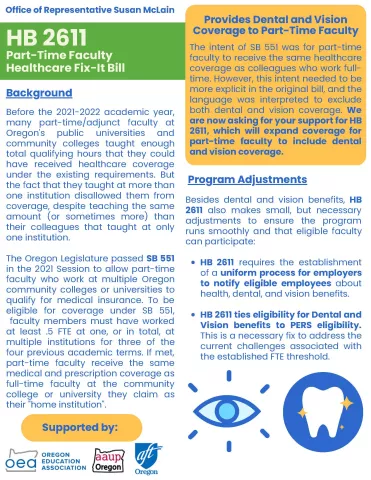Key Takeaways
- Most part-time or adjunct faculty don’t have access to employer-provided health care. And they can’t afford to buy it on their own.
- Oregon union members have been working on this issue for more than a decade. In 2023, they won critical legislation that will expand part-time faculty’s access to health care, including dental and vision.
- Your voice matters! Oregon faculty spoke up—and were heard.
For years, the money that Nick Nash made as a “part-time” instructor at Oregon’s Blue Mountain Community College barely stained his bank account. It came in and he then zipped out to pay for his health insurance.
Nash’s policy for himself and his partner “cost thousands of dollars a month,” even though he purchased it on the state-run insurance exchange, he recalls. But the alternative—not having insurance at all—seemed potentially worse. “I [paid], but it just made you sick—it was so much money.”
So, when Nash found out that his union, the Oregon Education Association (OEA), was pursuing a statewide solution to provide the state’s part-time faculty with affordable, employer-provided coverage, he jumped at the chance to help. “The opportunity [to get health care] was transformational—for my life and for the life of many other adjuncts,” he says. “I’d been doing this for years—money in, money out—and I didn’t know how I could go on. To not have to worry about health insurance, and to have dental and vision too? It would make me feel like an important part of the community, like the work that I’m doing is valued, that it matters, that it is recognized.”

And that’s exactly what Nash told Oregon lawmakers, in testimony earlier this year. They heard him—and other union members—loud and clear. As a result, House Bill 2611, which expands part-time faculty’s access to employer-provided health care benefits, including vision and dental, was approved by state lawmakers and signed into law by Gov. Tina Kotek on July 31. The bill was co-sponsored by Rep. Susan McLain and recommended by OEA.
A Persistent Problem in Oregon and Everywhere
The problem of part-time faculty’s access to health care has been persistent for years, and not just in Oregon. Most of the time, “part-time” faculty like Nash and thousands of others don’t work part-time hours. Many teach at multiple colleges—driving around their city or state from campus to campus—so that they can piece together a living wage. Because their work is spread across multiple employers or otherwise falls below their institution’s cap, they don’t get access to their employer’s group plan.

Nash, who has a Ph.D. in philosophy, teaches three classes a quarter. “It feels pretty full-time to me!” he says, noting the work in grading papers, planning lessons, talking to students, etc., that happens away from the classroom.
A decade ago, “A Portrait of Part-Time Faculty Members” found that just 22.6 percent of adjuncts had health insurance through their employers. More recently, a 2022 survey found that less than half (about 45 percent) were getting employer-provided health insurance.
Being a union member helps—a lot. In addition to pursuing legislation, some unions bargained for health care access. The part-time faculty union of the City Colleges of Chicago, for example, negotiated for its members to get money from the college system (up to $175 a month) to defray the cost of health care.
But, of course, the problem isn’t just health care. It’s also low pay and little access to retirement benefits. “My colleagues and I deserve a fair wage, health insurance, and the possibility we might get to retire before we die,” Massachusetts adjunct Margaret Crowe said last year, in testimony to her state’s lawmakers.
Meet the Oregon Educators Who Need Health Care
OEA’s legislative efforts to get health care benefits for part-time or adjunct faculty have been in the works for more than a decade. They took a huge step forward in 2021, when union members urged lawmakers to pass Senate Bill 551, aimed at providing the same healthcare coverage to part-timers as full-time faculty.
The people they had in mind were educators like Rebecca Owen. When Owen testified to Oregon House Committee on Education members, in 2021, she told them she was working as a part-time instructor on three college campuses. “While I work full-time hours, I don’t get benefits from any of the places I work for,” she said.
In 2016, she tore the MCL in her knee. “Since I was uninsured, I had to pay for MRIs and physical therapy out of pocket and with credit cards—despite the fact that I was teaching seven classes at three different schools, two of which are part of the Oregon community college system,” Owen said, in written testimony. “I didn’t get surgery because I couldn’t afford to do so at the time. My knee still hurts, and I walk with a limp.”
“I do think my treatment options would have been different if I had health insurance from my employers,” she continued. “While I know my case isn’t as dire or as life-threatening as other part-time instructors might have experienced, and I know I’m lucky to have been able to pay for my care with credit cards and my savings and my orthopedic doctor’s income-based payment plans, I still can’t help but feel the sting of getting injured while also being employed at three schools, teaching seven writing classes, and having to choose my treatment options based on my lack of insurance.”
And Owen isn’t the only one.
Quote byMaria Julia Sorrentino , Oregon community college instructor

“Please help me.”
“This fall my foot started hurting—[with] every step I walk. I can’t afford to go to the doctor to find out what is wrong, pay for tests like x-rays, and other office visits, like physical therapy… I just live with the pain and walk slowly,” Natalie Holliday, a math instructor at Rogue Community College told lawmakers.

Holliday couldn’t afford to go to the doctor because she couldn’t afford insurance. The lowest-cost plan available to her through Rogue, at the time of her testimony in 2021, was $200 a month. Meanwhile, she was getting paid less than $1600—and her rent cost $900, utilities $250, car insurance and gas another $100 or so. Her son covered the costs of her phone. Any leftover earnings? It went to buy food.
Maria Julia Sorrentino, an instructor at Clackamas Community College for 20-plus years, has had on-and-off access to the college’s health care insurance during her decades there. (Far more off years than on.) The ongoing uncertainty around health care contributes to the overall precariousness of part-time faculty’s jobs. Will they get a class to teach, or not? Will they have money to pay the rent, or not? “I do it because I love my students and I love this job, and I want to serve my community, but I can't work any harder than I already am,” Sorrentino told lawmakers. “Please help me get the health care I need and deserve.”
In 2021, lawmakers listened—and passed SB 551. It was a great first step, but more work still needed to be done. The 2021 law didn’t include vision and dental, and it enabled colleges to come up with their own formulas to count employees’ working hours and figure out who would get access. While Nash got access at rural Blue Mountain, many other part-time faculty at other, larger community colleges did not. The new legislation, which became law August 1, uses one, statewide formula, which means more part-time faculty will be able to access the health care they need and deserve as critical educators.
For Nash, the benefit isn’t just about accessing affordable health care—although that is important. It’s about feeling recognized, as a committed and hard-working educator of his rural community’s students. “If I wasn’t teaching philosophy here, nobody would be. It’s nice to feel like it matters,” he says. “Honestly, I’m grateful to the state of Oregon for doing this and showing us the respect as educators that, quite frankly, our institutions won’t show us. To me, anyway, it meant a lot that legislators did this.”


